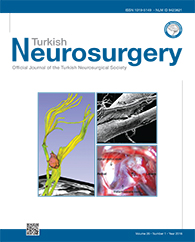2Kasimpasa Military Hospital, Department of Neurosurgery, Istanbul, Turkey DOI : 10.5137/1019-5149.JTN.7320-12.2 AIM: The purpose of this study was to investigate the risk factors for the development of the central large disc herniations and to compare the demographic data between central mass prolapse and broad-based central disc herniation.
MATERIAL and METHODS: Between 2002 and 2007, 1630 patients underwent surgery and a large disc herniation was the main problem in 59 patients (3.6%). We performed a retrospective analysis of the demographic data of these patients. Magnetic resonance (MR) images were evaluated according to the disc type and level. Variables were evaluated both at baseline and follow-up, with special emphasis on physical job characteristics, sports activities, and MR - based morphologic findings.
RESULTS: Central large disc herniation was diagnosed in 59 patients consisting of 41 males and 18 females. The average age was 34.7 years. 36 patients had a central mass prolapse that occupied more than 50% of the spinal canal. Intraoperative observations confirmed that 29 out of 36 central disc prolapse patients (80.5%) had intact posterior longitudinal ligaments. Interestingly, the condition in these 29 patients was found to have a direct relation with age and occupation or other body training sports activities.
CONCLUSION: The size of the large central disc herniation, physical activity, age and gender are major factors in the development of disc herniation.
Keywords : Large lumbar disc herniation, Outcome, Physical Activity




